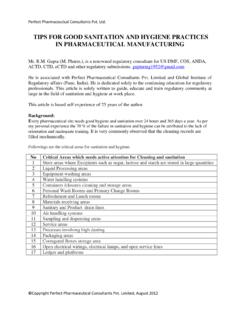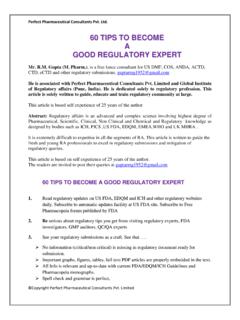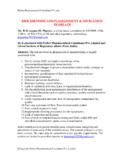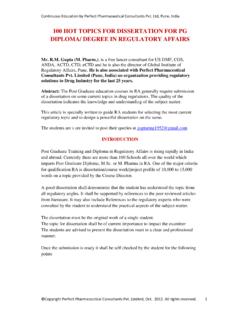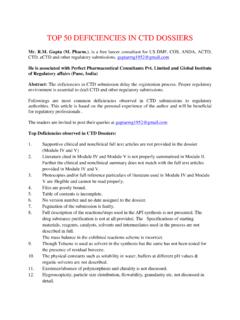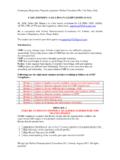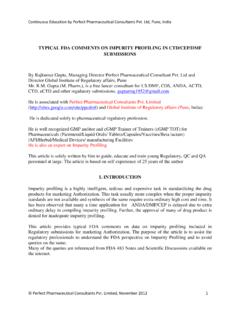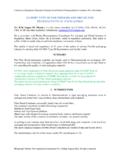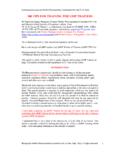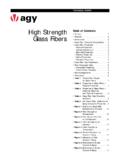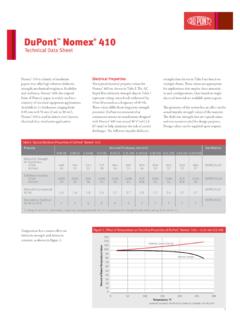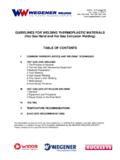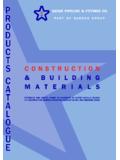Transcription of U.S. Regulations for Flexible Pharmaceutical Packaging ...
1 Perfect Pharmaceutical Consultants Pvt. Ltd. Copyright Perfect Pharmaceutical Consultants Pvt. Limited 1 Regulations for Flexible Pharmaceutical Packaging Materials Mr. Gupta (M. Pharm.), is a free lance consultant for US DMF, COS, ANDA, ACTD, CTD, eCTD and other regulatory submissions. He is associated with Perfect Pharmaceutical Consultants Pvt. Limited and Global Institute of Regulatory affairs (Pune, India). He is dedicated solely to regulatory profession. This article is solely written to guide, educate and train regulatory community at large. This article is based self experience of 25 years of the author in serving Flexible Packaging Industry for meeting their US DMF Type III Registrations and Facility Audit Summary: The Flexible Packaging materials are largely used in Pharmaceuticals for blister Packaging of tablets and sachet packing of dispersible powders.
2 Almost 75 % of oral tablets and powders are packaged in US are packaged in Flexible materials. US 21 CFR and USP 34 NF 29 have prescribed a set of specification for controlling the quality of such materials. US FDA also offers registration of Flexible Packaging materials under US DMG Type III. A very large number of Indian Companies have upgraded their site to meet US FDA requirements and have applied for US DMF. This article is written to guide Flexible Packaging material manufacturers/exporters/processors to know current US FDA requirements and to upgrade their facilities accordingly The author has person experience for filing US DMF Type III for Packaging materials for large number companies including HINDALCO. Introduction: Flexible Packaging in context to Pharmaceuticals is non-rigid Packaging structures used to package and protect various drug products such as tablets, capsules, powders for medical use.
3 Flexible Packaging covers materials that have undergone a conversion process including printing, lamination, coating and extrusion, and can involve different substrates such as plastic films, paper and foil. Flexible pack types include plastic bags, wrapping films, lidding films, aluminum foil laminates; foil lidding, blister Packaging , foil bags and sachets. Perfect Pharmaceutical Consultants Pvt. Ltd. Copyright Perfect Pharmaceutical Consultants Pvt. Limited 2 Flexible Packaging films can be made from: * Single materials such as PE, PP, polyester or PU * Multiple materials by coating, laminating or co extruding with the other materials The most common forms of Flexible Packaging are the strip package, blister package and the pouch. A blister package usually consists of a lidding material and a forming film. The lidding material is usually a laminate which includes a barrier layer ( , aluminum foil) with a print primer on one side and a sealing agent ( , a heat-sealing lacquer) on the other side.
4 The pouch is usually sealed from 3 sides and one side is kept open for filling and sealing thereafter. The sealing agent contacts the dosage form and the forming film. The forming film may be a single film, a coated film, or a laminate. Leak testing is usually performed on Flexible packages as part of the in-process controls According to one estimates, more than two-thirds of all medicines are delivered orally and are therefore likely to be packed in blisters/pouches/strips/bags The most common examples of Flexible Pharmaceutical Packaging materials are: Aluminum Foil, BOPP (biaxial oriented polypropylene), LDPE (low-density polyethylene) LLDPE (linear low-density polyethylene) OPP (oriented polypropylene) PA (polyamide) PE (polyethylene) PET (poly ethylene terephthalate), PP (polypropylene), PVC (poly vinyl chloride) PVDC (polyvinylidene chloride), as used singly or in laminate form.
5 A. The basic requirements for Flexible Packaging materials as per US FDA The product shall be manufactured as per cGMP Guidelines provided under directive 21 CFR parts 11. The products used for as primary Packaging of Pharmaceutical products shall be manufactured under clean room conditions meeting Class 1, 00,000 cleanliness standards. 1. The container shall meet all requirements under 21 CFR Direct Food Contact and physical tests in accordance to latest USP <661>: 2. The container shall protect the contents from environmental hazard and external influences ( moisture, light, oxygen and temperature variations) during its entire life time beginning from Packaging , transportation, handling and storage until use. 3. It shall not be composed, in whole or in part, of any poisonous or deleterious substance which may render the contents injurious to health 4.
6 It shall not be reactive, additive, or absorptive so as to alter the safety, identity, strength, quality, or purity of the drug beyond the official or established requirements. Perfect Pharmaceutical Consultants Pvt. Ltd. Copyright Perfect Pharmaceutical Consultants Pvt. Limited 3 5. The integrity of the Flexible material must be met throughout the whole of the intended shelf-life of the product. The materials shall be conditioned to the 23 C and 50% RH before conducting any QC/QA tests. 6. Recycled starting material or finished product is mostly not allowed. 7. The product shall be supported by Certificate of Analysis (COA) or Certificate of Certification (COC) from the component supplier and the performance of an appropriate identification test, provided the supplier s test data are periodically validated (21 CFR (d)(3)). 8. All test methods shall be fully described.
7 9. If a batch is to be accepted based on a supplier's COA or COC, then the procedure for supplier validation should be described. The data from the supplier s COA or COC should clearly indicate that the lot meets the applicant s acceptance criteria. 10. Dimensional information shall be provided via a detailed schematic drawing complete with target dimensions and tolerances 11. Description of the quality control measures used to maintain consistency in the physical and chemical characteristics of the material. 12. A complete description of the process and its validation should be provided. B. Characterization of Flexible Materials as per USP and US Drug laws: The Flexible Packaging materials are usually characterized as per below: Material specification, IR spectrums & DSC thermo grams of standard & sample Manufacturer s test report (COA) ,Dimensional drawing ,DMF authorization letter from manufacturers of resins and colorants ,Thermal analysis ,Light transmission ,Non-volatile residue ,Heavy metals ,Container permeation The following physical tests are performed in accordance to latest USP <661>.
8 Multiple internal reflectance s ( to ensure that the material of the container falls within the range of HDPE or LDPE as specified in the test) ,Thermal analysis (to check compliance to pre defined endotherms and exotherms temperatures) , Light transmission ( to check protection from light) ,Water vapor permeation ( to check protection from moisture permeation) Heavy metals , Nonvolatile residue. Perfect Pharmaceutical Consultants Pvt. Ltd. Copyright Perfect Pharmaceutical Consultants Pvt. Limited 4 Followings are the requirement of Flexible Packaging material as per US FDA standards. Please note that all the tests are not required to be performed routinely. The routine tests are marked with * The tests required at regular intervals (3 to 6 months) are marked with ** No Requirements Purpose 1 Material Name, product code, brief description, Materials of construction and the address of the manufacturing site shall be provided Material and site identification 2 Test Reports on Polymeric materials and auxiliary substances used in manufacturing Flexible laminates/.
9 To ensure suitability of each material(Suppliers Test report acceptable) 3 Description of the manufacturing process and operations A description of the quality control measures Description of the acceptance, in-process, and release controls To assess chemistry manufacturing and Control Procedures 4 Engineering Drawing To ensure length, width, thickness and arrangements of different polymeric layers in laminated material 5 Identification of individual Polymer Film by IR spectrophotometer To confirm the claimed identity of Polymer monitor consistency in composition 6 Identification of each layer of the laminate by combination of FTIR and Microscopy To confirm the claimed composition of the laminate 7 Identification of pigments and colorant such as Titanium dioxide by IR To confirm claim identity of colorant used 8 Identification of solvents retained after printing and lamination by To confirm that the product is free from solvents 9 Sealability.
10 It is determined by heat sealing the product at varying temperatures; dwell time and seal pressure To ensure protection from moisture, air, dust and microbial flora 10 Melt flow Rate; It is a measure of the viscosity of a molten polymer. It is useful for fixing processabilty of the polymer Perfect Pharmaceutical Consultants Pvt. Ltd. Copyright Perfect Pharmaceutical Consultants Pvt. Limited 5 11 Migration test/Extraction Test: Strips are cut from the packs and immersed for 24 hours in Hexane at 50C, Ethanol at 70C Water at 70C. The non volatile residue, the pH and heavy metal content of the aqueous extract are measured. These studies may be performed on routine basis also. The term migration refers to the transfer of non volatiles compounds between a pack, the product or the environment. One method is the use of FT-IR microscopy, where a migrant s migration is tracked by monitoring a particular wavelength due to the migrant through the thickness of the polymer.
